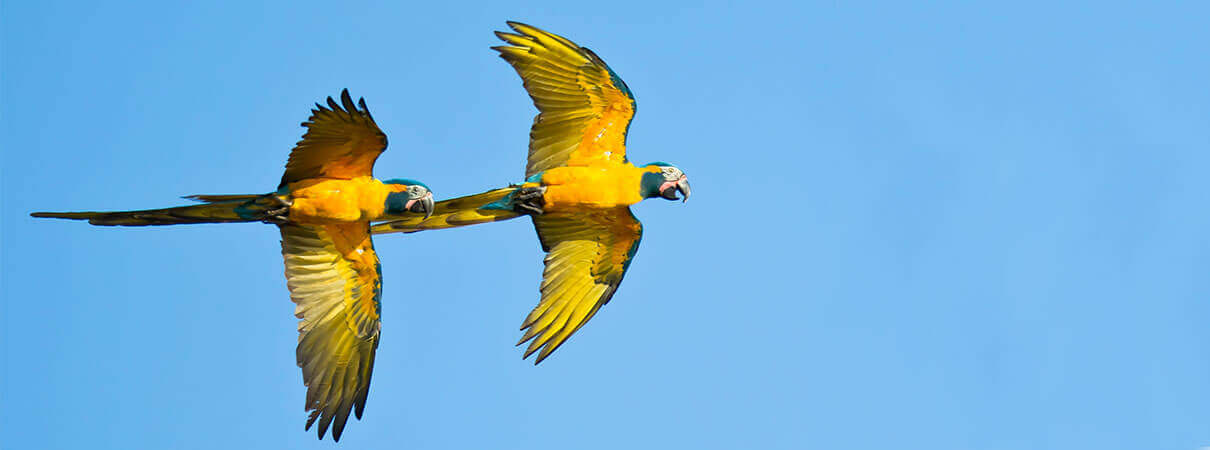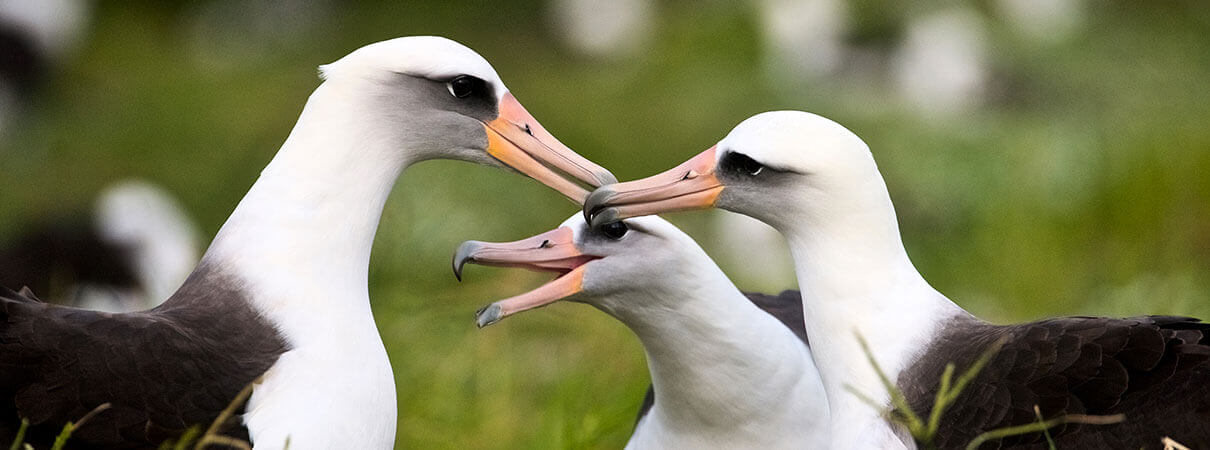10 Biggest Conservation Wins for Birds in 2018
From attacks on cornerstone bird protections to new drilling threats in sage-grouse country, 2018 held no shortage of challenges for birds and bird conservation. Despite these growing threats, American Bird Conservancy and its partners scored some remarkable wins over the last 12 months, defending birds from immediate risks while effectively addressing the long-term dangers that threaten their future in the Western Hemisphere. Below are 10 of ABC's biggest 2018 conservation wins for birds — a sampling of our conservation impact throughout the Americas.

Blue-throated Macaws by Paul B. Jones
1. Creating a New Reserve for Endangered Macaws
In August, the nesting area for the largest known group of breeding Blue-throated Macaws — a Critically Endangered species numbering only about 400 in the wild, all in Bolivia — was protected as a nature preserve, thanks to a land purchase made by the Bolivian conservation organization Asociación Armonía with support from American Bird Conservancy and others. The new reserve, one of our biggest conservation wins for birds, is named for longtime Blue-throated Macaw supporter Laney Rickman. Read more.
2. Declaring Victory for the Piping Plover
Piping Plovers that nest annually within New York's Jones Beach State Park are now safer, thanks to an August court settlement in which authorities agreed to remove feral cats from the park. The agreement marks the successful resolution of a two-year lawsuit that ABC launched in May 2016, over the state's failure to effectively implement Endangered Species Act (ESA) protections for this listed species. As a result, Piping Plovers are now receiving the protection they deserve, while cats at Jones Beach will be humanely trapped and relocated to a sanctuary. Read more.
3. Protecting Habitat in Peru
More than 500 bird species in northern Peru stand to benefit from a new community reserve, created by a local community in partnership with Asociación Ecosistemas Andinos (ECOAN) and ABC. The 39,915-acre Monte Puyo Private Conservation Area protects cloud forests and wetlands considered a conservation priority due to their extraordinary bird diversity, which includes the Endangered Ochre-fronted Antpitta and Speckle-chested Piculet. Read more.
In other good news for birds in Peru, ABC teamed up with ECOAN in September to purchase 104 acres that expanded the Abra Patricia Reserve to over 25,250 acres. The acquisition increases protected habitat for the Long-whiskered Owlet, one of the world's rarest birds, along with 23 other globally threatened bird species. Read more.

Kirtland's Warbler by Robert Royse
4. Stepping Up for Kirtland's Warbler
Thanks to extensive recovery efforts, Kirtland's Warbler populations have surged over the last 40 years, leading the U.S. Fish and Wildlife Service to propose their removal from the endangered species list. Making sure that these warblers continue to thrive, however, will require ongoing work and long-term habitat management. Thanks to major philanthropic support from the Harry A. and Margaret D. Towsley Foundation, ABC is working with a range of agency and nonprofit partners to develop a comprehensive strategy that addresses conservation needs after the Kirtland's Warbler is delisted. Read more.
5. Doubling Brazil's Araripe Manakin Reserve
One of Brazil's rarest birds, the Araripe Manakin, received much-needed support in March, when ABC and our Brazilian partner Aquasis protected more than 170 acres of its disappearing habitat. The newly protected area doubles the size of the existing Araripe Oasis Reserve and connects it to the much larger Araripe National Forest, providing new habitat — and hope — to a Critically Endangered bird species that numbers fewer than 1,000 individuals. Read more.

Cerulean Warbler by Tessa Nickels
6. Defending Migratory Bird Protections
When the Department of the Interior moved to reverse decades of government policy and practice by eliminating longstanding protections for waterfowl, raptors, and songbirds under the Migratory Bird Treaty Act (MBTA), ABC joined a coalition of environmental groups challenging the Department's decision in court. By defending the MBTA in court, we're working to ensure that one of the United States' most fundamental environmental laws remains intact and holds companies accountable for actions that harm birds. Read more.
7. Rediscovering the Bahama Nuthatch
For two years, conservationists feared that the last surviving Bahama Nuthatches would be counted among Hurricane Matthew's non-human victims on Grand Bahama Island. But researchers from the University of The Bahamas-North erased all doubts in May when they rediscovered the nuthatch with ABC's support. Buoyed by this success, researchers are now looking at ways to help this Critically Endangered bird recover. Read more.
8. Scoring Wins in Milwaukee, Chicago to Prevent Glass Collisions
Another of our biggest conservation wins for birds came in August when the world's first bird-friendly sports and entertainment arena, the Fiserv Forum, opened in Milwaukee. The Forum, which hosts the Milwaukee Bucks, sets a new precedent for bird-friendly building design, while helping reduce glass collisions that kill up to 1 billion birds each year. Bird City Wisconsin, with support from ABC and other groups, played a critical role in making Fiserv Forum's bird-friendly features a reality. Read more.
Northwestern University also worked with ABC to put itself in the vanguard of the growing bird-friendly building movement. With technical support from ABC, Northwestern is helping to reduce collisions by applying patterned window film to problematic windows and choosing glass with bird-friendly patterns for new construction projects. Read more.

Laysan Albatross by Enrique Aguirre/Shutterstock
9. Declaring Midway Lead-Free
Midway Atoll may sound like an idyllic spot for seabirds given its remote location in the Pacific Ocean, but lead contamination on the atoll's three islands has plagued its birds — including the world's largest population of Laysan Albatross — for decades. Recognizing the danger, the U.S. Fish and Wildlife Service, ABC, and other groups supported a 10-year clean-up effort that was successfully completed this August when the atoll was declared lead-free. Removal of the lead, which was contained within paint on the atoll's structures, will improve reproductive rates for albatrosses, including boosting recovery efforts for the Endangered Short-tailed Albatross. Read more.
10. Assessing Conservation Impact
In October, ABC released its first Conservation Impact Scorecard, which provides an “at-a-glance” summary of our cumulative conservation actions and outcomes. The scorecard provides conservation metrics in three sections according to the main components of ABC's strategic bird conservation framework. This first installment of ABC metrics for bird populations and our cumulative advances will be updated each year. Read more.
Want to keep up with ABC's biggest conservation wins for birds in 2019? Sign up for our eNewsletter.


















































